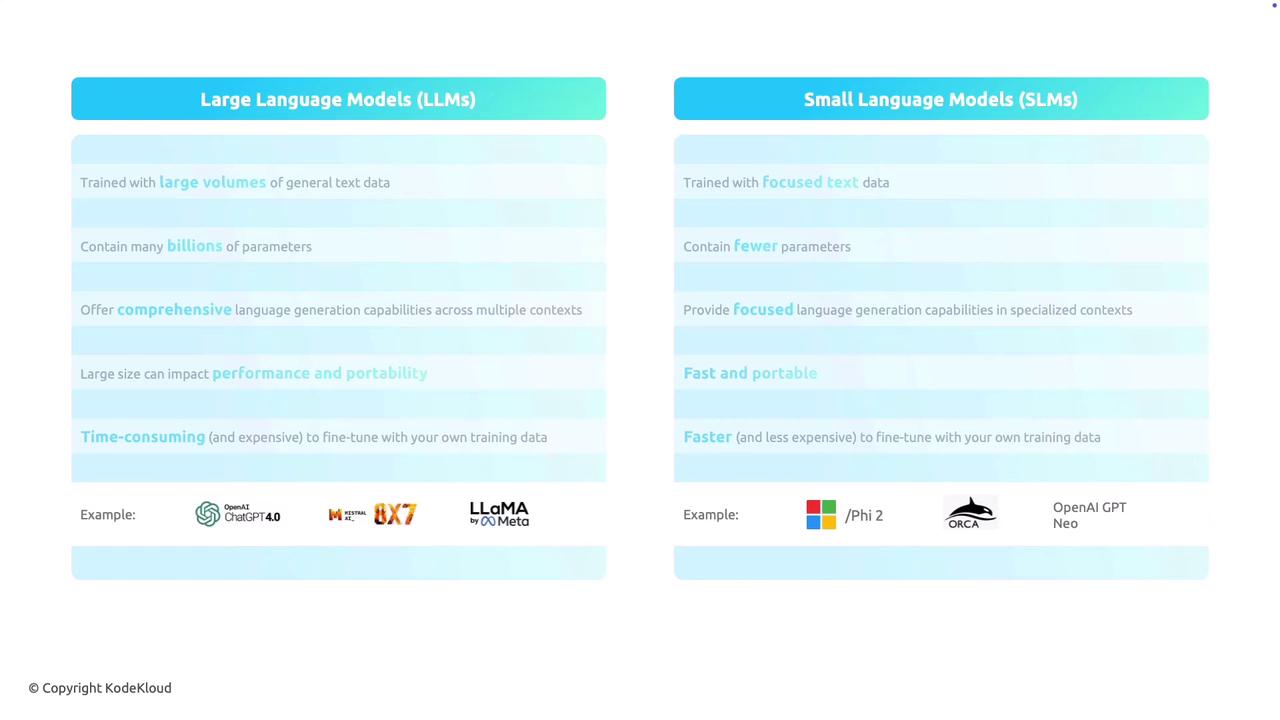AI-900: Microsoft Certified Azure AI Fundamentals
Generative AI
Large and Small Language Models
Large Language Models (LLMs) and Small Language Models (SLMs) have distinct architectures, training regimens, and strengths. In this guide, we explore their differences to help you choose the right model for your application.
Data and Training
LLMs are trained on extensive, diverse datasets that provide a broad understanding of language. This general training enables them to handle various contexts and subjects. In contrast, SLMs are developed using focused datasets, often tailor-made for specific topics or tasks. This targeted training makes SLMs highly effective within their specialized domains.
Model Parameters
One of the defining differences between these models is the number of parameters:
- LLMs: Often contain billions of parameters. These extensive parameter sets allow them to model complex language patterns and generate detailed, nuanced text.
- SLMs: Feature fewer parameters, resulting in simpler yet robust models that perform well in their specialized areas.
Capabilities
Each model type excels in different areas:
LLMs:
- Provide versatile language generation capabilities across multiple contexts.
- Are suitable for a wide range of applications, from creative writing to technical documentation.
SLMs:
- Deliver focused language generation that specializes in a particular industry or subject matter.
- Are optimized for efficiency and speed, particularly in targeted use cases.
Performance and Portability
Due to their large size, LLMs typically require significant computational resources, which may limit their portability and affect real-time performance. SLMs, with their leaner architectures, generally offer faster processing and greater portability. These advantages make SLMs ideal for deployment on devices with limited resources.
Note
When deciding between an LLM and an SLM, consider the trade-off between the model's versatility and deployment efficiency.
Fine-Tuning
Fine-tuning is a critical step in adapting a model for specific tasks:
LLMs:
- Fine-tuning these expansive models can be resource-intensive and expensive due to their complexity.
SLMs:
- Their streamlined design allows for quicker and less costly fine-tuning, making them practical for targeted applications.
Examples
Below are examples of models in each category:
Large Language Models (LLMs)
Examples include:
- OpenAI's GPT-4.0
- Mistral 7b
- LLaMA 3

Small Language Models (SLMs)
Examples include:
- Microsoft Copilot
- ORCAD 2
- OpenAI GPT Neo
Conclusion
Choosing between Large and Small Language Models depends on your specific needs. LLMs are ideal for complex, general-purpose language tasks, while SLMs excel in efficiency and specialized contexts. Understanding these differences can drive better decision-making for AI projects and tailored deployments.
For further reading and technical details, explore more on Kubernetes Documentation and Docker Hub.
Watch Video
Watch video content